|
FEATURES
The Ancient Tea Horse Road | China Heritage Quarterly
The Ancient Tea Horse Road
The Politics of Cultural Heritage in Southwest China
Gary Sigley
The University of Western Australia
Pu'er Mania
In 2005, a tea caravan (mabang 马邦) emerged out of the mists of time and made an epic journey from Yunnan 云南 to Beijing, from the 'periphery' to the 'centre'.[1] The caravan, consisting of forty muleteers and over one hundred mules, was transporting a precious four-tonne cargo of Pu'er tea cakes (普洱茶饼) from the tea producing regions of southeast Yunnan to the capital of the People's Republic. The tea was highly valued as 'tribute tea' (贡茶), calling to mind the time when precious commodities from across the empire were offered up to the imperial court, and also reflecting in the present the rapacious demand for luxury and exotic goods amongst China's nouveau riche (and, we might add, as gifts to curry favour with those in positions of power).
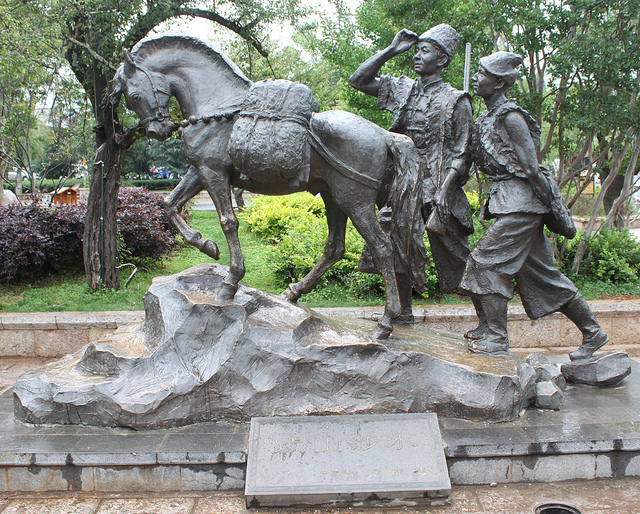
Fig.1 A bronze statue commemorating the Ancient Tea Horse Road in Lijiang, Yunnan province. (Photograph: Gary Sigley)
Pu'er tea, a distinctly Yunnanese form of broad leaf tea (camellia sinensis assamica), and possibly the first variety of tea ever to be consciously cultivated (as opposed to the harvesting of wild trees), had only recently emerged from relative obscurity to become a hot item for Chinese investors looking for the next big thing into which to channel piles of idle cash. Pu'er, unlike most varieties of tea, is ideally suited for investment as it can be stored for decades and, depending on the quality of the tea, will 'improve' with age. Some of the Pu'er tea cakes (the tea is compressed into small discs for ease of storage and transportation) were at this time fetching astronomical prices. Some cakes presented to this author were valued at over ¥200,000 yuan (the tea cake in question dated from the 1930s).
The media campaign associated with the tea caravan, which was at its heart a public-relations blitz (a 'cultural concoction' 文化炒作) added to the Pu'er frenzy by playing on the twin emotions of nostalgia and greed. Less than a year later the fantasies of quick fortunes built on expanding tea plantations and towering piles of Pu'er tea cakes came crashing down as the tea bubble burst, leaving many in the chain of tea production and consumption battered and bruised.[2]
This essay explores the confluence of cultural heritage, economic development and regional identity surrounding the multifarious representations of the 'Ancient Tea Horse Road' (Cha Ma Gudao, 茶马古道) of Yunnan. I argue that this caravan route as a loose conceptual totality is a fascinating example of how one particular 'object' can serve multiple purposes. First, the route is an assemblage of tangible and intangible heritage and cultural landscapes that has become the increasing focus of efforts related to heritage preservation and revitalisation. Secondly, the route is also a 'cultural resource' used as a marketing tool to promote tourism development. Finally, and perhaps most significantly, the route has become a narrative device used to evoke a sense of national and ethnic unity, one that is involved with the re-imagining of the importance of the periphery vis-à-vis the centre. The background for all of this is the profound cultural, social and economic transformations that are taking place in Yunnan, something that contributes to a widespread anxiety concerning the loss of the past and possibilities for the future.
Discovering the Tea Horse Road
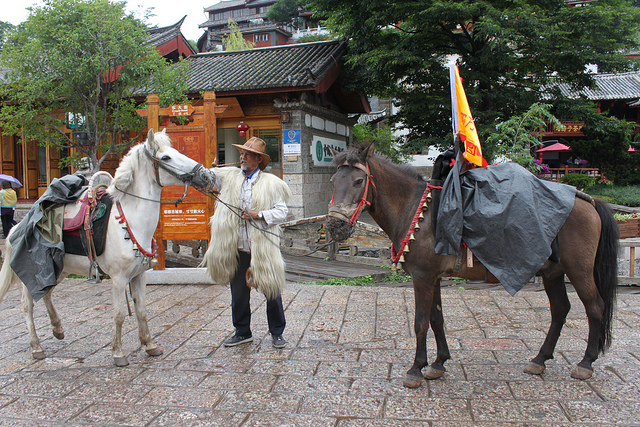
Fig.2 Tea horse tourism, Lijiang (Photograph: Gary Sigley)
The Ancient Tea Horse Road refers to a network of trading routes linking the tea producing areas of Yunnan (mainly concentrated in the southeast of the province in Pu'er 普洱 and Xishuangbanna/Sibsongbanna, 西双版纳) and Sichuan 四川 (around the area known as Ya'an 雅安) with the tea-consuming regions across China, but in particular with Tibet. The network first emerged in significant terms during the Tang dynasty (618–907), reaching its zenith during the late-Qing period (1790s to 1911) and the first half of the twentieth century. The network also extends into mainland southeast Asia, Nepal and India.[3] In this short account I focus on the route in Yunnan.[4] While there are many side routes, the tea road begins in Menghai 勐海 (Xishuangbanna), then proceeds to Pu'er (the first major trading town en route), and through to Fengqing 凤庆, Dali 大理, Lijiang 丽江, Zhongdian/Shangrila 中甸/香格里拉 after which it crosses into Tibet and lead to its final destination of Lhasa (as far as this particular route is concerned).[5]
The tea road, in what was approximately a six month caravan journey from Menghai to Lhasa, crosses innumerable rivers, including the Mekong 湄公河 or Lancang 澜沧江 (more than once) and Yangtze (known as the Jinsha River 金沙江 in Yunnan), and over many high mountain passes, some as high as 5,000 metres. In its progress the tea road traverses a range of distinct topographical zones, from the temperate rainforests of Xishuangbanna through to the high-altitude alpine forests and meadows of modern-day Shangrila.[6] It also passes through many different cultural zones inhabited by a diverse range of ethnic groups. In short, the tea road is located in the most topographically diverse region of the People's Republic of China, rich in flora and fauna (including one World Heritage biodiversity hot spot), and home to the largest number of ethnic groups, including the Dai 傣, Bai 白, Naxi 纳西 and Tibetans 藏.
Today the route still includes remnant paths and roads, bridges of various sorts (arched, cantilever, and cable), caravanserais (madian 马店), market towns (large and small), staging posts, and shrines and temples (including mosques and even a few Christian churches)—all elements of what is now termed 'tangible cultural heritage'. As for the intangible cultural heritage of the route, it consists of a trading network that highlights the centrality of tea in the lives of the many ethnic groups in Yunnan (and beyond). The 'intangible' also refers to the rapid disappearance of the caravan itself, which for as long as recorded history, using a variety of 'beasts of burden' (oxen, horses, donkeys, mules, yaks and, at times, people), was the main conduit for the transportation of goods and ideas to and from Yunnan.[7] The tea road was not only an important route for commercial activity (including the trade in tea, salt, medicinal products and luxury goods) but also for cultural exchange, especially between Tibet and Southwest China (it was another important entry point for Buddhism into China, in addition to the more well-known Silk Road). Under the relatively new rubric of 'cultural route heritage'[8] the State Administration of Cultural Heritage (SACH) is now working with government agencies in Yunnan to formulate an application to the United Nations for UNESCO World Heritage status (other Chinese sites on this tentative list include the Silk Road and the Grand Canal).[9]
Memory and Branding
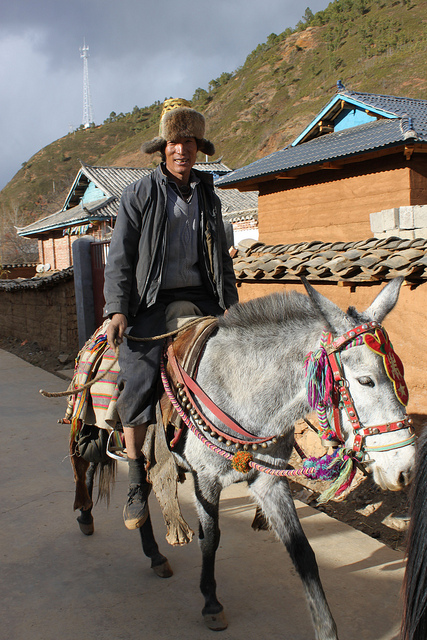
Fig.3 Horses and mules are still widely used in and around Yongning. There is a large horse and mule fair (骡马会) every year in November. This horse and rider were part of a five horse caravan. (Photograph: Gary Sigley)
China's cultural heritage authorities are thus finally taking the preservation of the cultures associated with the route seriously. Yet the recognition that the old tea road warrants lags far behind its conceptual development within the broader realm of public discourse. Indeed, it may even be argued that the 'cultural heritage lag', and its recent corrective in the form of 'World Heritage frenzy',[10] is partly a response to the economic and tourist potential that the tea road offers. The production, transportation and consumption of tea—Pu'er tea in this case—is itself a tangible item which has generated over time a series of associated social and cultural practices that unites the disparate peoples of Yunnan. Thus, the tea road and tea fit comfortably into the marketing vision of Yunnan as a 'cultural whole' and feature in all the counties, towns and cities that are touched on by them as a key element of provincial 'branding'.
For instance, the image of a mule laden with tea cakes (carefully wrapped in dried bamboo leaves, seven cakes per package—what are called qizibing 七子饼) being led by a muleteer clad in simple mountain attire with an old musket or crossbow slung over his shoulder is now commonplace and it has entered the popular imagination.[11] 'The Ancient Tea Horse Road' is now directly associated with and used as a marketing icon for Pu'er tea itself. More significant, however, is the association of the 'tea road' to a range of other forms of cultural heritage tourism.
There are now at least two tea horse road theme parks in Yunnan (one in Pu'er and another in Menghai). Visitors to ancient tea horse road staging posts such as Shuhe 束河 (in Lijiang) are offered rides through the ancient (and new) cobblestone streets of the town supposedly to experience firsthand the ancient route on the back of a horse (mules, perhaps due to their odd and unsightly appearance, seem to be excluded from this activity). Further down the road, the recently renamed town of Pu'er now markets itself as the 'origin of tea and the starting point of the [tea] road' (茶之源,道之始). As part of what is no doubt incorporated in a tourism development plan, in 2010 the township hosted an inaugural 'Puer Ancient Tea Horse Road Festival' (普洱茶马古道节).[12]
Part of the fascination with the tea road, other than its obvious colourful and exotic dimensions, is a form of nostalgia for times past being experienced by a society undergoing rapid social transformation (Sigley, 2010). The loss of a particular way of life is real and was captured in the Beijing-based director Tian Zhuangzhuang's 2004 film, Delamu (茶马古道:德拉姆), which follows the travails of people living in the rugged fringes of the Nu River 怒江 (known as the Salween when it flows into Myanmar/Burma) Gorge, along the remote border of Yunnan and Tibet, where small caravans are still part of daily life. It has also featured in a TV drama of the same name—The Ancient Tea Horse Road 茶马古道—which describes the role of the route during the height of the war with Japan. As the makers of the tele-drama are at pains to highlight, at this crucial time for China and the Allies it was only through the mobilisation and collaboration of different local peoples along the ancient tea road that efforts of the invaders were frustrated.
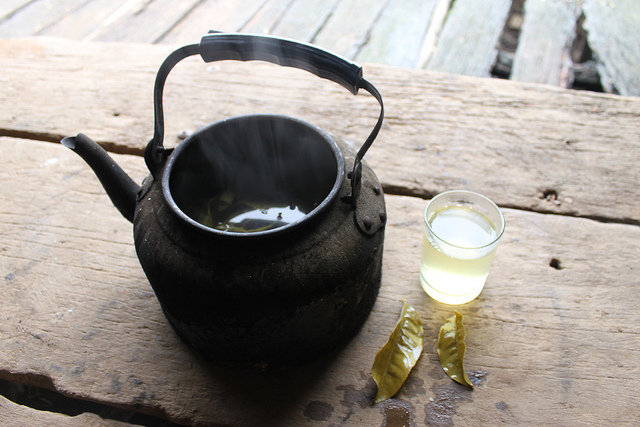
Fig.4 Villagers in the village of Mannuo, Yunnan province, brew tea from fresh tea leaves. (Photograph: Gary Sigley)
As Tim Oakes notes, it was in the early 1990s that the Beijing government put 'culture' clearly on the development agenda. On 10 January 1990, People's Daily carried a speech by the then Minster of Culture Li Ruihuan 李瑞环 entitled, 'Some Questions Relevant to Enhancing the Outstanding Aspects of National Culture' (关于弘扬民族优秀文化的若干问题). The speech contained the standard remarks about culture, nationalism and legitimacy, but also it also pointed to an economic agenda for local government in which 'culture' was to become an important artefact. This marks the beginnings of China's contemporary cultural industry. Oakes refers to this as the country's '"cultural turn" in regional development strategies', one in which 'cultural resources [including repackaged and reinvented cultural heritage] have come to be viewed as possessing equal if not greater economic potential than traditional factor endowments typically marshalled by local governments in their development planning'.[13] As a consequence over the past two decades the tea route has emerged as a powerful form of cultural branding in Yunnan. It is a noteworthy development given the fact that the formulation 'Ancient Tea Horse Road' did not exist prior to 1990.
Asserting Regional Identity
In the aforementioned TV drama, The Ancient Tea Horse Road, set in the 1940s, the protagonists anachronistically make reference to 'the rules of the Ancient Tea Horse Road' (茶马古道的规则). The term 'cha ma gu dao' was in reality the collective invention of six scholars, often referred to as the 'six gentlemen' (六个君子) who, in the early 1990s travelled extensively through the border regions of Yunnan, Sichuan and Tibet. The outcome of these journeys was the seminal book, An Exploration of the Great Cultural Triangle of Yunnan, Sichuan and Tibet (滇川藏大三角文化探秘) in which the notion of the 'Ancient Tea Horse Road' was first articulated. The book, written in the casual essay style of Chinese (散文) rather than the disciplinary based prose of the social sciences, explored the role of tea in cultural exchange amongst the peoples of Yunnan, Sichuan and Tibet.
The Chinese saying tian shi di li ren he (天时地利人和) which stresses the intersection of 'time, place and people' seems to aptly describe the fortuitous circumstances surrounding the birth of the concept of the 'Ancient Tea Horse Road'. First, the early 1990s was a historical juncture of relative uncertainty. The People's Republic had just passed through the first decade of 'reform and openness'. The initial wave of economic, social and cultural change had roiled from the eastern seaboard to remoter parts of western China. Although there was some uncertainty as to whether reform would continue in the immediate aftermath of the crackdown following the Protest Movement of 1989, there was a heightened sense of expectancy. When Mu Jihong, one of the 'six gentlemen',[14] and his colleagues published their book in 1992 few realised that with the announcement of the 'socialist market economy' at the Fourteenth Party Congress in the same year China would enter a period of even more rapid, intense and profound change. As local governments scoured their own localities for appropriate cultural artefacts to form the basis of cultural branding and tourism, the tea route in Yunnan readily found itself a welcome home in the plans of local government, tourism developers and Pu'er tea producers. As the economic boom continued, the tea route and its associated imagery found fertile soil in the imagination of a general public, now with increased leisure time and disposable income as well as an interest in romantic escapism and readily satisfied nostalgia not too far from the comforts of home.
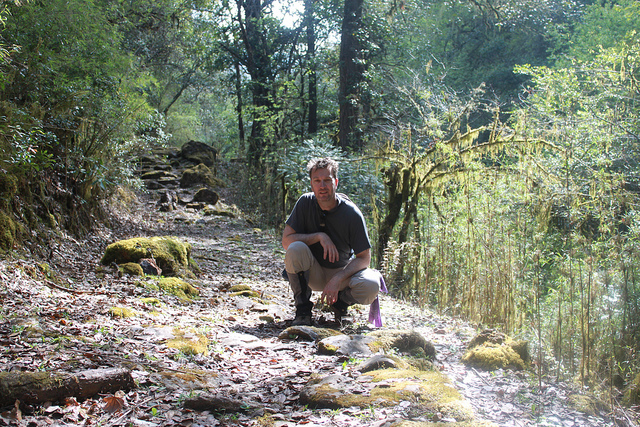
Fig.5 The author, on the Ancient Tea Horse Road (Photograph: Gary Sigley)
Secondly, in terms of place, the Yunnanese scholars found themselves in a difficult situation. On the one hand, they were concerned about how the unique cultures of Yunnan may be affected by the changes yet to come. The tea route was a convenient label that covered the complex set of cultural exchanges and landscapes of Yunnan. Yet on the other, they also wanted Yunnan to break out of its relative isolation and play catch up with the pace of economic and social change taking place along the eastern seaboard of the country. As the east continued to develop, seemingly leaving Yunnan further behind, these scholars lamented the lack of recognition of the importance of Yunnan as a commercial and cultural thoroughfare between central China, Tibet and mainland Southeast Asia. Rather than seeing Yunnan as an isolated backwater they argued that it should be acknowledged as one of China's important links to the outside world. In this sense the formulation of the tea route was an attempt to put Yunnan back on the map, so to speak, and to have the route recognised alongside the Silk Road—what Yunnanese scholars refer to as the 'Northern Silk Road' (北方丝绸之路), the Tang-Tibetan Ancient Road (唐蕃古道) and the Southern Silk Road (南方丝绸之路).[15] This reconfiguration between centre and periphery not only relates to Yunnan's position vis-à-vis the rest of China, but to mainland Southeast Asia and the subcontinent as well. Tea road maps now depict a variety of trading routes connecting Pu'er to Beijing, Lhasa, Nepal, Vietnam, Myanmar and Laos.
Finally, in terms of people, the concept of the ancient tea route struck a chord with those espousing a renewed sense of regional identity. Yunnanese scholars were proud of the 'home grown' nature of the route and, on numerous occasions, the present writer has been reminded that, unlike the Silk Road—a term coined in the 1870s by the German geographer Ferdinand Freiherr von Richthofen—the ancient tea-horse route was conceptually conceived by indigenous, Chinese scholars.
Nonetheless, the appearance of the tea route has not been without a measure of academic controversy. Scholars outside Yunnan, in particular those in Sichuan, have expressed concern that the 'tea road' has been hijacked. These critics argue that while the concept of a 'tea road' between Yunnan and Lhasa is valid, there is a paucity of material evidence that can match the claims of historical continuity and significance that is attributed to it. They argue that the tea road between Ya'an in Sichuan and Tibet has a much stronger claim on longevity. For a long period beginning in the Song Dynasty (960-1279), dynastic rulers controlled the tea trade between Ya'an and Tibet through an official 'Tea and Horse Bureau' (茶马司), and substantial records on the amount of trade are extant in both Chinese and Tibetan. More recently, other tea producing regions and locations with trading routes with Tibet have also begun to assert their connections to the 'tea road'. There is now, for example, a growing body of research emerging from Qinghai and the China's Northwest in this regard. The ancient tea horse road as a concept covering the exchange of tea and culture through the mountainous trading networks between Southwest China and Tibet is now expanding. What this will mean for the development of regional identity and cultural tourism remains to be seen.[16]
Conclusion
Yunnan, it seems, is now at last catching up. The transport infrastructure is undergoing a major upgrade (at enormous expense given the terrain). Kunming, the provincial capital, now more resembles a massive construction site than the quiet and laidback place it used to be. Places like Lijiang have been catapulted into the twenty-first century and become major destinations for both domestic and international tourism. The anxiety around cultural and social change that concerned Yunnanese scholars in the early 1990s now looks like coming to reality, and with a scale and force nobody could have anticipated. It is at this moment that the Ancient Tea Horse Road, with already twenty years of development and deployment as a form of cultural branding, a marker of regional identity, a platform for promoting national unity and a signifier for a past that is irrevocably lost, will find its second wind.
Notes:
[1] There were two different caravans, one in 2005 that set out under the banner of 'The Ancient Tea Horse Road Bearing Precious Tribute for the Capital' (茶马古道瑞贡京城), and another in 2006 that styled itself the 'Caravan Tribute Tea Traversing the Endless Miles [to the capital]' 马帮贡茶万里行. The money raised from the sale of the puer from the first caravan was donated to the well-known Communist Youth League charity 'Project Hope' (希望工程). There were numerous reports in the Chinese media at the time. See: http://www.cnr.cn/minzu/mzdt1/200510/t20051017_504116722.html (accessed on 22 March 2012); http://news.sina.com.cn/s/2005-08-18/03516717469s.shtml (accessed on 22 March 2012). The commercial value of these public relations and media events associated with the tea road and Pu'er tea (even in the case of raising money for charity) was evident when the organiser of the first caravan attempted to sue the organiser of the second caravan for infringement of intellectual property. A Kunming court ultimately squashed the case declaring that no infringement had occurred. See: http://www.yndaily.com/html/20070612/news_93_184539.html (accessed on 22 March 2012).
[2] The rise and fall of Pu'er has been covered in the Chinese media. See, for example: http://news.xinhuanet.com/comments/2007-06/26/content_6291109.htm (accessed on 22 March 2012); http://news.sznews.com/content/2008-07/24/content_3131527.htm (accessed on 22 March 2012). At the height of 'Pu'er mania', Simao, long known as one of the key Pu'er tea trading markets, was renamed as 'Puer' in order to capitalise on the growing fortunes of Pu'er tea even as those very fortunes were on the brink of collapse.
[3] The term 'tea road' is also used in Mary Avery's 2003 work to describe the caravan tea trade between northern China and Russia. Within China, however, the term 'Ancient Tea Horse Road' almost exclusively refers to the network of trading routes described here, with the addition of Sichuan and Qinghai. It is also worth noting that while in some contexts the term 'tea' and 'horse' refers to the exchange of Chinese tea for Tibetan horses (and those of other peoples of the steppe specialising in horse breeding), in Yunnan this form of dynastic controlled exchange was much less significant. For work on the system of exchange of tea for horses in Sichuan, see Paul Smith (1991).
[4] For a contemporary travel account of the tea road from Yunnan to Tibet, see Jeff Fuchs (2008) and his article in this issue of China Heritage Quarterly.
[5] Note that the place names listed here refer to current preferences. Place names for some staging posts, towns and regions have changed over time.
[6] The rich and unique flora was particularly attractive to Western 'flower hunters' in the nineteenth and twentieth centuries. For an overview of the 'flower hunters' and other Western explorers in the region, see Glover, et al (2011).
[7] For a detailed overview of 'caravan culture', see Wang and Zhou (2008).
[8] A cultural route is defined as, 'a land, water, mixed or other type of route, which is physically determined and characterized by having its own specific and historic dynamics and functionality; showing interactive movements of people as well as multi-dimensional, continuous and reciprocal exchanges of goods, ideas, knowledge and values within or between countries and regions over significant periods of time; and thereby generating a cross-fertilization of the cultures in space and time, which is reflected both in its tangible and intangible heritage.' http://whc.unesco.org/en/tentativelists/5335/ (accessed on 22 March 2012).
[9] For descriptions of the Silk Road and the Grand Canal as they appear on the tentative list, see: http://whc.unesco.org/en/tentativelists/5335/ (accessed on 22 March 2012); and, http://whc.unesco.org/en/tentativelists/5318/ (accessed on 22 March 2012) respectively. The author attended the first ever national meeting on the cultural heritage of the ancient tea horse route at which the proposal to lodge an application for World Heritage status was first made public. See, http://www.chinawatch2050.com/puer-ancient-tea-horse-road-cultural-heritage-forum-june-2010 (accessed on 22 March 2012).
[10] The link between cultural tourism development and the 'World Heritage craze' (世界遗产热) is discussed in Sigley (2010).
[11] Public sculptures on this theme can be found in Menghai, Pu'er, Lijiang and Shangrila.
[12] See: http://expo.people.com.cn/GB/58536/11072325.html (accessed on 22 March 2012).
[13] Tim Oakes, 'Cultural strategies of development: implications for village governance in China', The Pacific Review, 19:1, 2006:14. The important role of culture in terms of domestic development and governance, and as a form of soft power, was most recently reaffirmed in the 18 October 2011 'Central Committee Resolution Question Concerning the Deepening Reform of the Cultural System and Developing a Flourishing Socialist Culture' (中共中央关于深化文化体制改革推动社会主义文化大发展大繁荣若干重大问题的决定) which states that 'Culture is increasingly becoming an important source of creativity and unity amongst the nation, is increasingly a crucial element of overall national strength, and increasingly becoming a vital support for economic and social development'. (http://www.gov.cn/jrzg/2011-10/25/content_1978202.htm [accessed on 22 March 2012]).
[14] For an interview with Mu Jihong, see: http://www.chinawatch2050.com/interview-with-professor-mu-jihong
[15] For a more recent historical revisionist account see Yang Bin (2008).
[16] The sources for this section are taken from the author's personal communications with scholars in this field and from the as-yet-unpublished work of Frank Booz, who is completing a doctoral dissertation focusing on the tea trade between Ya'an and Tibet.
Sources
Martha Avery, The Tea Road: China and Russia Meet Across the Steppe, Beijing: China Intercontinental Press, 2003.
Jeff Fuchs, The Ancient Tea Horse Road: Travels with the Last of the Himalayan Muleteers, New York: Penguin Group, 2008.
Denise M. Glover, et al, Explorers and Scientists in China's Borderlands, 1880-1950, Seattle: University of Washington Press, 2011.
Mu Jihong, et al., An Exploration of the Great Cultural Triangle of Yunnan, Sichuan and Tibet (Dian Chuan Zang Da San Jiao Wenhua Tanmi, 滇川藏大三角文化探秘), Kunming: Yunnan Daxue Chubanshe, 1992.
Tim Oakes, 'Cultural strategies of development: implications for village governance in China', The Pacific Review, 19:1, 2006:13-37.
Gary Sigley, 'Cultural Heritage Tourism and the Ancient Tea Horse Road of Southwest China', International Journal of China Studies, 1: 2, 2010:531-544.
Paul J. Smith, Taxing Heaven's Storehouse: Horses, Bureaucrats, and the Destruction of the Sichuan Tea Industry, 1074-1224, Cambridge, Mass.: Harvard University Press, 1991.
Wang Mingda and Zhou Xilu, Horse Caravan Culture (Mabang Wenhua 马帮文化), Kunming: Yunnan Renmin Chubanshe, 2008.
Yang Bin, Between Winds and Cloud: The Making of Yunnan, New York: Columbia University Press, 2008.
Email: gary.sigley@uwa.edu.au
Website: www.chinawatch2050.com
|